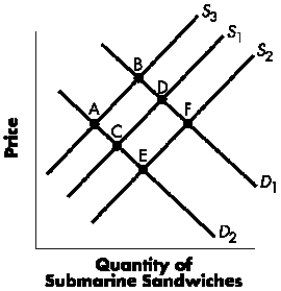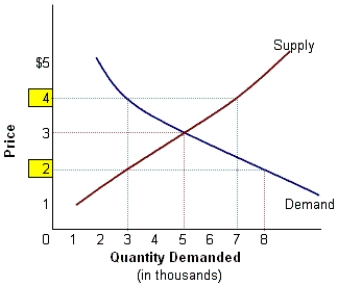A) Taxes
B) Import restrictions
C) Duties
D) Subsidies
Correct Answer

verified
Correct Answer
verified
Multiple Choice
A simultaneous increase in demand and decrease in supply would lead to:
A) increase in the equilibrium price and a decrease in the quantity sold.
B) increase in both the equilibrium price and the quantity sold.
C) decrease in both the equilibrium price and the quantity sold.
D) uncertain effect on the equilibrium price but an increase in the equilibrium quantity.
E) uncertain effect on the equilibrium quantity but an increase in the equilibrium price.
Correct Answer

verified
Correct Answer
verified
Multiple Choice
If the electronics market is experiencing a shortage in the supply of mobile phones being sold at a cost that buyers are more than willing to pay for, then:
A) the selling price is higher than the equilibrium price
B) the equilibrium price is higher than the selling price.
C) the quantity demanded is less than the quantity supplied.
D) the shortage could be eliminated by lowering the price.
Correct Answer

verified
Correct Answer
verified
Multiple Choice
American consumers decide to boycott soccer balls made by Nike in support of a ban on child labor.Everything else being equal, the:
A) price of Nike soccer balls will rise.
B) supply of Nike soccer balls will fall.
C) quantity of Nike soccer balls supplied will fall.
D) demand curve for Nike soccer balls shifts to the right.
Correct Answer

verified
Correct Answer
verified
Multiple Choice
Other things constant, a decrease in the price of fertilizer will:
A) increase the supply of wheat.
B) decrease the supply of wheat.
C) increase the demand for wheat.
D) decrease the demand for wheat.
E) do none of the above.
Correct Answer

verified
Correct Answer
verified
Multiple Choice
If both the supply and demand curves shift to the left, then we can conclude that there will be a(n) :
A) increase in the equilibrium quantity sold.
B) decrease in the equilibrium quantity sold.
C) increase in the equilibrium price.
D) decrease in the equilibrium price.
E) a change in quantity that is indeterminate.
Correct Answer

verified
Correct Answer
verified
Multiple Choice
Ceteris paribus, if negotiations lead to lower wages for airline employees, what will be the result in the market for air travel?
A) an increase in equilibrium price and an increase in equilibrium quantity
B) an increase in equilibrium price and a decrease in equilibrium quantity
C) a decrease in equilibrium price and an increase in equilibrium quantity
D) a decrease in equilibrium price and a decrease in equilibrium quantity
E) an increase in equilibrium price and an indeterminate change in equilibrium quantity
Correct Answer

verified
Correct Answer
verified
Multiple Choice
Figure 3-H  -Refer to Figure 3-H.A decrease in the quantity demanded, but not a decrease in demand, occurs when the equilibrium moves from:
-Refer to Figure 3-H.A decrease in the quantity demanded, but not a decrease in demand, occurs when the equilibrium moves from:
A) Point B to Point D.
B) Point D to Point B.
C) Point D to Point C.
D) Point C to Point D.
E) None of the above are correct.
Correct Answer

verified
Correct Answer
verified
Multiple Choice
Figure 3-K  -Refer to Figure 3-K.The equilibrium price is:
-Refer to Figure 3-K.The equilibrium price is:
A) $3
B) $1
C) $4
D) Indeterminate
Correct Answer

verified
Correct Answer
verified
Multiple Choice
Whenever there is a surplus at a particular price, the quantity sold at that price will equal:
A) the quantity demanded at that price.
B) the quantity supplied minus the quantity demanded.
C) the quantity supplied at that price.
D) (quantity demanded plus quantity supplied) /2.
Correct Answer

verified
Correct Answer
verified
Multiple Choice
Table 3-D Use the following information about demand and supply schedules to answer the question. -Refer to Table 3-D.Suppose that D2 and S1 are the prevailing demand and supply curves for a product.If the supply schedule changes from S1 to S2, then:
A) equilibrium price decreases from $10 to $8.
B) equilibrium quantity decreases from 15 to 12.
C) equilibrium quantity increases from 10 to 12.
D) equilibrium price increases from $10 to $12.
E) equilibrium quantity remains at 15.
Correct Answer

verified
Correct Answer
verified
Multiple Choice
Table 3-D Use the following information about demand and supply schedules to answer the question. -Refer to Table 3-D.If D1 and S2 represent the demand and supply schedules in a particular market, the equilibrium price and quantity are ____ and ____, respectively.
A) $12; 9
B) $10; 12
C) $10; 8
D) $8; 11
E) between $8 and $10; between 10 and 12
Correct Answer

verified
Correct Answer
verified
Multiple Choice
Table 3-C -Refer to Table 3-C.What is the equilibrium price in the example?
A) $1.60
B) $1.40
C) $1.20
D) $1.00
E) $0.80
Correct Answer

verified
Correct Answer
verified
Multiple Choice
Which of the following is the correct way to describe equilibrium in a market?
A) At equilibrium, demand equals supply.
B) At equilibrium, quantity demanded equals quantity supplied.
C) At equilibrium, market forces no longer apply.
D) Equilibrium is a tendency for price to change, a state of perpetual motion.
E) At equilibrium, the "fairest" price for output is achieved.
Correct Answer

verified
Correct Answer
verified
Multiple Choice
Figure 3-K  -Refer to Figure 3-K.At a market price of $2, which of following conditions exist?
-Refer to Figure 3-K.At a market price of $2, which of following conditions exist?
A) Shortage
B) Surplus
C) Equilibrium
D) Either a or b
Correct Answer

verified
Correct Answer
verified
Multiple Choice
When a demand schedule is drawn in a graph:
A) price is measured on the vertical axis.
B) quantity is measured on the horizontal axis.
C) the resulting curve has a negative slope.
D) other variables are held constant.
E) all of the above are correct.
Correct Answer

verified
Correct Answer
verified
Multiple Choice
Suppose there is a reduction in consumer income and an increase in the price of jet fuel, an important resource used to produce air travel.If air travel is a normal good, how will these changes influence the price and quantity of air travel? The price of air travel will (be) ____ and quantity purchased will (be) ____.
A) decrease; indeterminate
B) increase; indeterminate
C) decrease; decrease
D) indeterminate; decrease
Correct Answer

verified
Correct Answer
verified
Multiple Choice
A demand curve shows the relationship between price and quantity demanded, "other things remaining constant." The other things that remain constant include all of the following except the:
A) price of the product.
B) price of complementary products.
C) price of substitute products.
D) number of consumers in the demographic group purchasing the product.
E) preferences of consumers.
Correct Answer

verified
Correct Answer
verified
Multiple Choice
If both the supply and demand for computer games increase, then the equilibrium price of the games:
A) is indeterminate and the equilibrium quantity rises.
B) is indeterminate and the equilibrium quantity falls.
C) falls and the equilibrium quantity also falls.
D) falls and the change in equilibrium quantity is indeterminate.
Correct Answer

verified
Correct Answer
verified
Multiple Choice
Figure 3-G
The diagram below represents the market for butter.  -Refer to Figure 3-G If the current price of butter equals $5, you would expect to find:
-Refer to Figure 3-G If the current price of butter equals $5, you would expect to find:
A) the market in equilibrium at 2,000 pounds per year.
B) the market in equilibrium at 8,000 pounds per year.
C) that the market is not in equilibrium, and that the quantity supplied is greater than the quantity demanded.
D) that the market is not in equilibrium, and that the quantity demanded is greater than the quantity supplied.
Correct Answer

verified
Correct Answer
verified
Showing 161 - 180 of 252
Related Exams